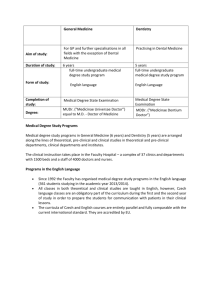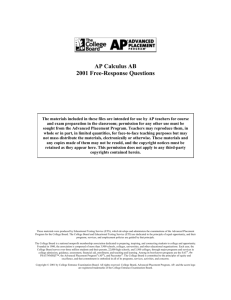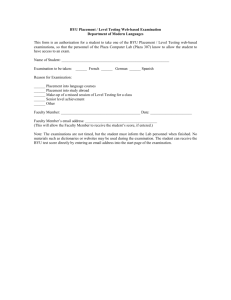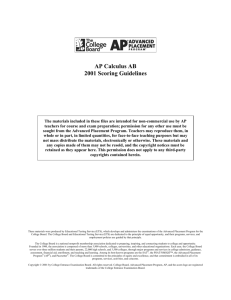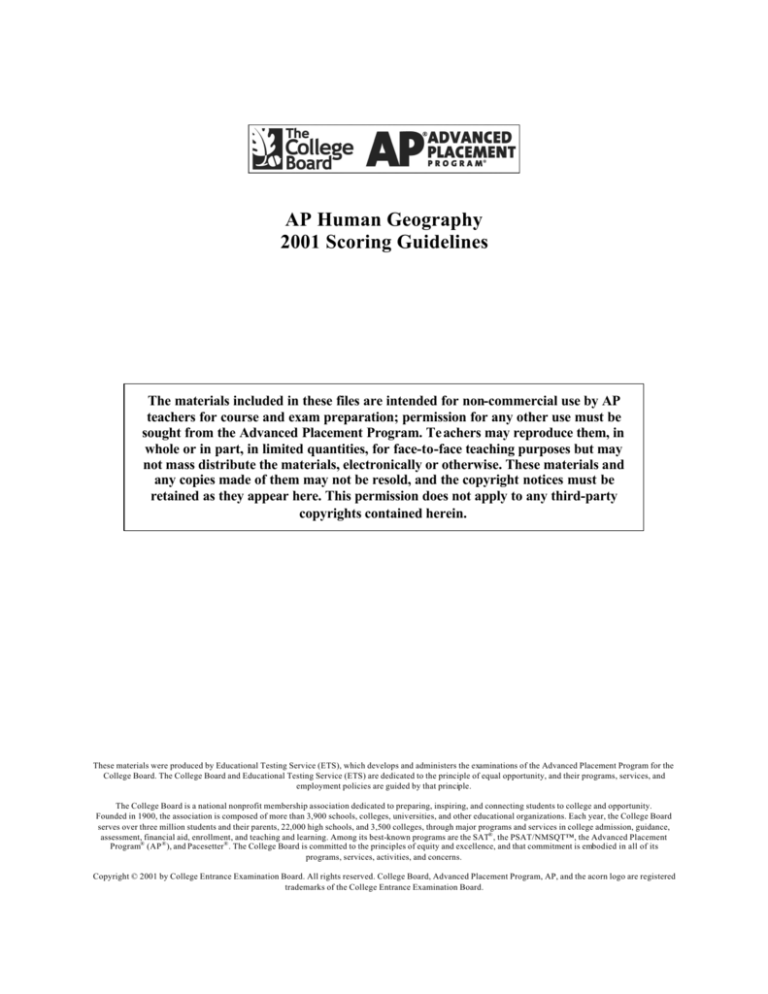
AP Human Geography
2001 Scoring Guidelines
The materials included in these files are intended for non-commercial use by AP
teachers for course and exam preparation; permission for any other use must be
sought from the Advanced Placement Program. Te achers may reproduce them, in
whole or in part, in limited quantities, for face-to-face teaching purposes but may
not mass distribute the materials, electronically or otherwise. These materials and
any copies made of them may not be resold, and the copyright notices must be
retained as they appear here. This permission does not apply to any third-party
copyrights contained herein.
These materials were produced by Educational Testing Service (ETS), which develops and administers the examinations of the Advanced Placement Program for the
College Board. The College Board and Educational Testing Service (ETS) are dedicated to the principle of equal opportunity, and their programs, services, and
employment policies are guided by that principle.
The College Board is a national nonprofit membership association dedicated to preparing, inspiring, and connecting students to college and opportunity.
Founded in 1900, the association is composed of more than 3,900 schools, colleges, universities, and other educational organizations. Each year, the College Board
serves over three million students and their parents, 22,000 high schools, and 3,500 colleges, through major programs and services in college admission, guidance,
assessment, financial aid, enrollment, and teaching and learning. Among its best-known programs are the SAT® , the PSAT/NMSQT™, the Advanced Placement
Program® (AP ® ), and Pacesetter® . The College Board is committed to the principles of equity and excellence, and that commitment is embodied in all of its
programs, services, activities, and concerns.
Copyright © 2001 by College Entrance Examination Board. All rights reserved. College Board, Advanced Placement Program, AP, and the acorn logo are registered
trademarks of the College Entrance Examination Board.
AP® HUMAN GEOGRAPHY
2001 SCORING GUIDELINES
Question 1
1. (a) (i) Both of these elements for 1 point
•
•
New strains with higher yields; increases in agricultural productivity
Changing agricultural practices (e.g., commercialization, shift from subsistence to
commercial farming)
1. (a) (ii) Any two of these for 1 point
•
•
•
•
•
Artificial fertilizer
Irrigation
Insecticides and herbicides
Mechanical machinery (e.g., tractors)
Hybridization; crossbreeding (e.g., “. . . for disease resistance”)
1. (a) (iii) 2 points
South Asia
India
Asia
Latin America
Northern Africa
Southeast Asia East Asia South America Central America
Indonesia
China
Mexico
Vietnam
Philippines
Not credited:
• Europe, Africa, United States
• An answer based on an incorrect linkage of a country with a crop; no credit even though
region is on credited list (e.g., “coffee in Colombia,” “apples in China”).
Credited:
• A response that names India and China, though arguably in the same “region,” will
receive 2 points; this will probably be the only exception to this rule.
• Countries within a region will be credited for that region.
• No overlapping (e.g., “China and Asia,” “India and South Asia”).
Copyright © 2001 by College Entrance Examination Board. All rights reserved.
Advanced Placement Program and AP are registered trademarks of the College Entrance Examination Board.
2
AP® HUMAN GEOGRAPHY
2001 SCORING GUIDELINES
1. (b)
Credited:
• Availability of credit/banks, money (e.g., international aid, finance, seeds, etc.)
• Political stability
• Receptive political environment
• Middle class (independent) farmers
• Market economy
• Transportation system
• Cultural acceptance of crops and practices (e.g., “Culturally, the society must be willing
to part ways with old fashioned methods of farming”).
• Knowledge, education
4 points possible, to be determined as follows:
Condition 1
Condition 1
ID only
ID + Description
= 1 point
= 2 points
Condition 2
Condition 2
ID only
ID + Description
= 1 point
= 2 points
Not Credited:
• Availability of space
• Crop rotation
1. (c) 4 points
These must be CAUSES — not effects — and the discussion must say why the factor(s) may
limit the long-term success of the practices/technologies.
•
•
•
•
•
•
•
•
•
•
•
Increased costs of artificial fertilizer, herbicides, insecticides, fuel
Decline in soil qua lity (fertility)
Water pollution
Finite supply of water à Water table
à Drought
Some groups (e.g., women) cannot obtain credit (equality)
Crushing debt load (e.g., for farmers, nations, governments, etc.)
Operation of commodity markets (e.g., “global econo my”)
Availability of funds (e.g., for additional equipment, seeds, etc.)
Climatic factors (e.g., erosion, desertification, etc.)
Limited amount of arable land (for 1 ID point only)
Potential loss of biodiversity (1 point for assertion that one crop will disappear;
2 points only if there is a convincing argument about how loss of biodiversity will
increase the costs of agricultural practices to limit its success)
Not Credited:
• Political instability (unless tied to economic factors)
Copyright © 2001 by College Entrance Examination Board. All rights reserved.
Advanced Placement Program and AP are registered trademarks of the College Entrance Examination Board.
3
AP® HUMAN GEOGRAPHY
2001 SCORING GUIDELINES
Question 2
Overall: 3 points possible for each of three discussions. Pick the best two elements/discussions
that a student offers in a response.
3 points
Good discussion of any two major elements
2 points
Good discussion of one major element and one other element; OR good discussion
of two other elements; OR limited discussion of two major elements
1 point
Discussion of one major element OR discussion of one other element
0 point
No major elements or other elements discussed
2. (a) Transportation
Major elements:
•
•
Freeways and transport corridors increased accessibility to the suburbs for individuals
OR freeways opened up large areas of cheap land for development of low-cost
housing by developers
Cars became more affordable, greater availability/access
Other elements:
•
•
Decline of street car system
Multiplier effect with commerce decentralizing (relocation outside of central business
district)
2. (b) Housing
Major elements:
•
•
•
Affordability due to organization of production: large developers could purchase
land, materials, designs at cheaper unit costs, and they could subcontract (in 1949
70 percent of new homes were constructed by 10 percent of the companies)
Affordability improved due to “methods”: prefab, assembled on site, division of labor
into crews that cut labor costs, speed of production
Financing easier to obtain — quick system, plus federal guarantees
(FHA- insured mortgage and 1944 GI Bill)
Other elements:
•
Tax codes that favor construction of new buildings rather than rehab
of old buildings (and loan programs that fa vored new construction not
repairs/upgrades)
Copyright © 2001 by College Entrance Examination Board. All rights reserved.
Advanced Placement Program and AP are registered trademarks of the College Entrance Examination Board.
4
AP® HUMAN GEOGRAPHY
2001 SCORING GUIDELINES
2. (c ) Landscape Preferences
Major elements:
• An anti big city feeling: escape the built environment and its density, pollution,
congestion; rural idyll is the opposite
• Desire for large home size — ranch style design as indicative of expansionist mood
• Desire for single family
• Suburbs as seen in popular culture (e.g., images in media, “the American way”)
Other elements:
• Desire for an ethnically homogenous and conformist landscape
• Desire for large yard/lot size
2. (d) Social and demographic trends
Major elements:
• Baby boomers provided demographic demand for housing expansion (market- led)
• Nuclear family in demographic terms
• “Model” family units (replaced extended family ideal); i.e., social construction of the
family
• Male as primary bread winner norm encouraged by GI Bill (wage); accompanied by
women as homemakers, placing of women in suburbs (cult of domesticity)
Other elements:
• White flight and, more generally, desire of ethnic/race groups to flock together
• Middle class value children’s education and view inner cities as providing inferior
product
Copyright © 2001 by College Entrance Examination Board. All rights reserved.
Advanced Placement Program and AP are registered trademarks of the College Entrance Examination Board.
5
AP® HUMAN GEOGRAPHY
2001 SCORING GUIDELINES
Question 3
Generic Rubric
3 points maximum per section and 3 points for examples.
Some students attempt answers to all four sections; always use the best three.
3 points
Good process oriented understanding of how ONE factor links Rostow to
contemporary economic and social change OR a more limited discussion of
two or more factors
2 points
Discussion of one factor that is incomplete in some way
1 point
Identification of relevant factor without relevant/accurate discussion
0 point
Attempt to answer but no relevant content
–
Off task
Examples: 3 points maximum
A single country may be used as an example for more than one part of this question if it is
appropriate.
3 points
Good appropriate example (almost always at the country level) for two or
more parts of the question
2 points
Less convincing mostly country level examples for two parts of question
OR a good example for only one part
1 point
Example countries not exactly appropriate
0 point
All examples are very general and inaccurate
Factors
3. (a) A country’s role in the world economy
Good process-oriented understandings will be positive, neutral, or negative when describing
the usefulness of Rostow.
•
•
•
•
Rostow stage equates role to shift from resource export (early stages) to rise of
industrial economy and mass consumption
Core-periphery vs. Rostow
Membership in supranational organization (e.g., NAFTA, OPEC)
Labor exporting region (e.g., Mexico)
Copyright © 2001 by College Entrance Examination Board. All rights reserved.
Advanced Placement Program and AP are registered trademarks of the College Entrance Examination Board.
6
AP® HUMAN GEOGRAPHY
2001 SCORING GUIDELINES
3. (b) Colonial transport networks
Most good process-oriented understandings will be negative on Rostow.
•
•
External orientation to colonizer, e.g., transportation focused on ports with links to
centers of resource exploitation — most important function is to link resource
exploitation area to world market or local labor supply to world market
Limits the internal growth of transportation system and related settlement pattern
(urbanization) to nature of colonial transport network — no reason for colonial power
to develop complete transportation network or modernize it hence neither economic
diversity nor growth is encouraged
3. (c) Cultural differences
Most good process-oriented understandings will be negative on Rostow.
•
•
•
•
•
•
•
Religion — Hindus (although more than a religion) may hinder development of
middle class because of caste system preventing upward mobility
Language — different languages may provide barriers to information flow and full
participation in economic processes
Political beliefs — governments may wish to isolate their population from
westernization to exert greater control over their subjects and territory
Profit motive — some populations may not move through the stages because of a lack
of interest in cash profit
Colonial legacy — departed colonial rulers left behind a social and economic system
(neo-colonial) that concentrates the majority of wealth in the hands of a few and/or
did not create a social infrastructure capable of allowing the population to engage in
new forms of economic activity
Gender — gender roles in cultures limit participation of entire population in economy
thereby limiting growth potential
Instability and violence/war — direct destruction of necessary population,
infrastructure, wasting local wealth and discouraging investment from outside
Copyright © 2001 by College Entrance Examination Board. All rights reserved.
Advanced Placement Program and AP are registered trademarks of the College Entrance Examination Board.
7
AP® HUMAN GEOGRAPHY
2001 SCORING GUIDELINES
3. (d) Local social and class structures
Most good process-oriented understandings will be negative on Rostow.
•
•
•
•
Class divisions — small elite group may control vast majority of wealth and have no
incentive to invest in new forms of economic activity or may prevent training of
majority of population
Lack of emergence of middle class — in countries with no middle class it is hard to
have skilled labor and business people emerge who will carry economy to later stages
or limited national marker for locally produced products.
Gender — gender roles within a state may create regional variations in economic
participation or result in population growth that retards affects economic development
Ethnicity — inter-group hostility may create situations where infrastructure is
destroyed, population lost, or some groups prevented from economic participation
thereby preventing the country from moving from one stage to another; OR a group
may refuse to participate and they may hinder the rest of the country’s population
from achieving the conditions necessary for advancement
Copyright © 2001 by College Entrance Examination Board. All rights reserved.
Advanced Placement Program and AP are registered trademarks of the College Entrance Examination Board.
8


